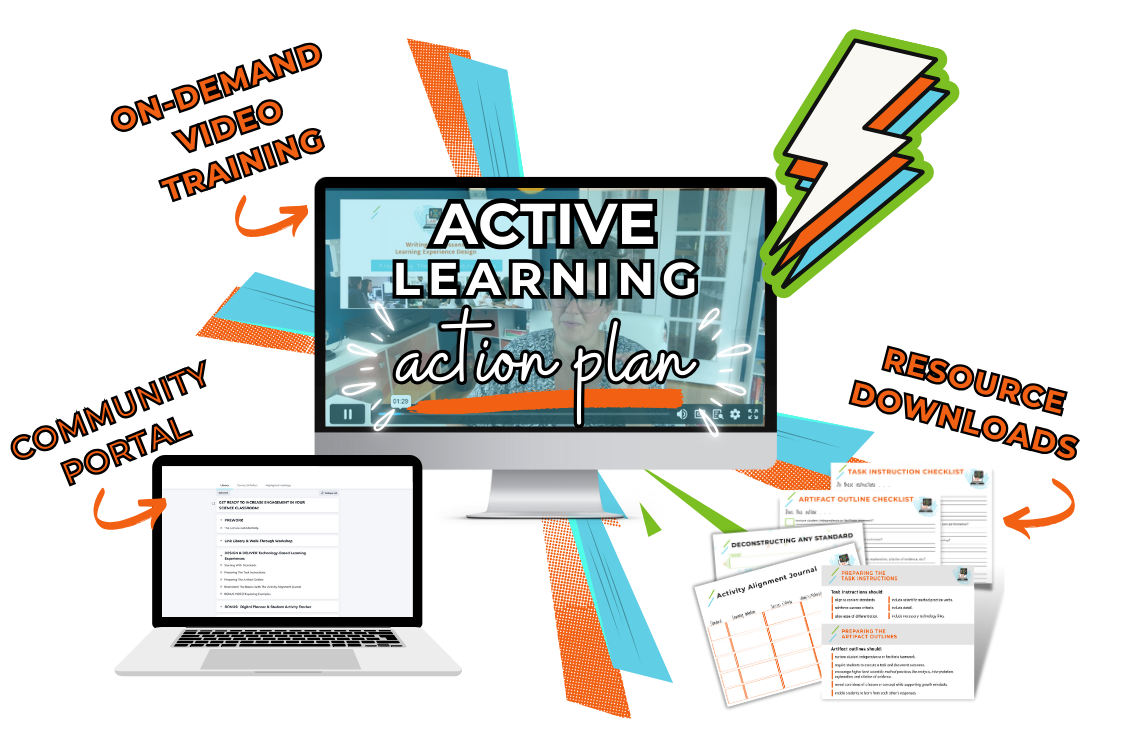Surely, you’ve encountered that classic classroom question: “Why do we even have to learn this?”
Whether it’s recently come from this year’s classroom or your own distant memories as a student, topics like electron configurations can easily fall into the “Why bother?” category!
But what if you could transform this concept into a cornerstone of student engagement?
In this article, we’ll explore how to teach NGSS chemistry by turning electron configurations into an evidence-based activity that highlights periodic patterns. Through inquiry-driven methods, students won’t just memorize configurations—they’ll use them as a foundation for engaging in argument from evidence, one of the key NGSS science and engineering practices. By focusing on active learning strategies, you’ll keep students curious, engaged, and confident in their understanding of chemistry.
Ready to see how this lesson comes to life? READ ON or watch the video below to discover how to turn your lesson on electron configurations into an engaging, NGSS-aligned activity that empowers students to explore evidence-based arguments and uncover periodic patterns in chemistry.
If you teach a different science content area, stick around! These resources were prepared with you in mind, too! You’ll learn how these principles of lesson plan design can be adapted to engage students in your own content area.
Why Inquiry-Based Approaches Work For teaching Electron Configurations in NGSS Chemistry
Our goal in teaching electron configurations doesn’t have to just be about how electrons fill orbitals—when we’re teaching with active learning principles and the NGSS in mind, it’s about guiding students to think critically, uncover patterns, and connect these abstract concepts to the broader structure of matter. Students step up to all those challenges in this lesson which is built around periodic patterns as dictated by the NGSS for chemistry in the standard related to structure and properties of matter (HS-PS1-1.). This standard requires that students use the periodic table as a model to predict relative properties of elements based on outermost electron patterns.
Furthermore, one of the main tenets of the NGSS is that students learn best when they’re actively engaged in the process of science. This means they aren’t passively absorbing information; they’re building models, evaluating evidence, and using what they discover to argue core ideas. It’s about giving students the tools to think like scientists. After all, brains don’t work by sitting still—they thrive on activity, curiosity, and challenge.
This lesson also embodies a shift in teaching philosophy: moving away from a lecture-heavy, fact-driven approach to a more student-centered, inquiry-based model. In these types of classrooms, mistakes are not only welcomed—teachers recognize them as essential. Students are encouraged to grapple with the content, revise their understanding, and take ownership of their learning. Our goal should be to create a classroom where every day is an opportunity for students to create new knowledge.

A Lesson Framework For Teaching Any NGSS Chemistry Lesson
This electron configuration lesson fits within a carefully designed sequence that builds on prior knowledge and scaffolds new concepts. It is strategically positioned within a larger sequence to build confidence and scaffold understanding. By the time students reach this point, they’ve explored key foundational ideas like the Bohr model, atomic radius trends, and the basics of Schrödinger’s model through interactive simulations. These earlier lessons provide the tools and context needed to tackle electron configurations with greater depth.
This framework condenses the traditional 5E model—commonly used in middle school—into a format that fits the faster pace of high school NGSS chemistry instruction while maintaining a focus on active, student-centered learning.
By braving through some “comfortable struggle,” students gain confidence in their abilities and leave class equipped for future challenges.

A warm-up activity integrates ngss chemistry cross-cutting concepts
Lessons begin with a purposeful activity that activates prior knowledge and prepares students for the day’s objectives. Students revisit key concepts like the Aufbau principle and energy levels in orbital diagrams, connecting these ideas to patterns in the periodic table. This structured approach ensures students are ready to engage while allowing you to assess their readiness to move forward.
Student-Centered Objectives include NGSS Chemistry disciplinary core ideas and more
Students are introduced to clear learning intentions and success criteria in a way that answers their natural question: “Why do I need to learn this?”
Success criteria range from engaging in the activity to reflecting on mastery, empowering students to take ownership of their progress.
Engaging observation Activity encourages NGSS Chemistry science and engineering practices
Students apply skills learned in prior lessons and use artifact outlines to document their work and analyze evidence systematically. Such outlines are designed to guide them through tasks involving resources like videos, texts, or simulations, ensuring they can extract key information and apply it effectively.
Data-Dependent Analysis supports more ngss chemistry science practices and Skill Practice prepares students for assessments
The lesson requires students to reflect upon the models they construct and search for pattern, engaging in arguing from evidence.
NGSS Chemistry: A Teacher’s Guide to Teaching Electron Configurations

Review & Preview: A Foundation for teaching electron configurations
This lesson begins with a structured review and preview activity, emphasizing energy comparisons within orbital diagrams, Schrödinger’s model of the atom, and electron configurations. These activities activate prior knowledge and build a strong foundation for deeper exploration aligned with NGSS chemistry standards.
Specifically, this review requires students to recall and apply knowledge learned in the introductory electron configuration lesson—the idea that lower-energy orbitals fill before higher-energy ones—and connects this concept to observable patterns in the periodic table. Through comparisons, students explore relationships between orbitals of the same shape (such as 2s and 3s) and different shapes within the same energy level (like 2s and 2p). These randomized comparisons solidify key ideas, such as: the further an electron is from the nucleus, the higher its energy.
A pivotal part of this warm-up involves asking students what they can infer about the energy of a 4s orbital compared to a 3d orbital, using calcium as a case study. Though the 4s orbital lies farther from the nucleus, it fills before the 3d orbital because of its lower energy level. This apparent contradiction invites students to engage in evidence-based reasoning, examining visual models and drawing meaningful conclusions—a key practice in NGSS chemistry.
I’ve met chemistry teachers who don’t ever teach students this skill, but visual aids like orbital diagrams help students transition from memorization to inference-based understanding. By grounding discussions in NGSS-aligned practices, students analyze and interpret data, gaining skills they can apply to future lessons and assessments.

Learning Intentions and Success Criteria: clarifying goals when teaching electron configurations
The primary focus of this lesson is using the periodic table as a predictive tool to sort and describe electron configurations. This approach aligns with NGSS chemistry standards by integrating patterns, evidence, and student-centered inquiry.
Building on foundational skills like filling Bohr diagrams, the lesson pushes students toward fluency with the periodic table as a model. The learning intentions emphasize their ability to:
- use patterns in the periodic table to predict electron configurations.
- understand how electron configurations inform an atom’s chemical properties.
The success criteria encourage students to go beyond simple diagram completion by reflecting on connections between patterns and atomic behaviors. Guided discussions reinforce their ability to apply these insights in future contexts, such as explaining periodic trends and chemical reactivity.
By the end of the lesson, students should confidently describe electron configurations, use the periodic table as a dynamic model, and connect these configurations to real-world chemistry concepts.

Observation Activity: collecting Electron Configuration Evidence to Reveal periodic Patterns
This observation activity immerses students in NGSS chemistry practices, guiding them through a structured exploration designed for teaching electron configurations and revealing their connection to periodic properties. By focusing on both metal and nonmetal atoms, specifically groups 1A and 2A as well as groups 6A and 8A of the periodic table, the activity provides students with a manageable yet comprehensive investigation of atomic structure and periodic trends.
Students analyze three representative elements from each group, filling out Aufbau diagrams and documenting their findings. This hands-on approach not only reinforces the concept of orbital filling but also emphasizes the connections between electron configurations and periodic properties—a core goal of teaching electron configurations within the NGSS framework.

Identifying Patterns in Electron Configurations Per NGSS Chemistry Cross-Cutting Concepts
As students complete their diagrams, they work collaboratively to uncover recurring patterns across elements. These patterns are essential for understanding the periodic table’s structure and its predictive power:
- Group 1A elements: a single highest-energy electron resides in the s-orbital (e.g., 2s, 3s, 4s).
- Group 2A elements: two highest-energy electrons occupy the s-orbital, with their distance from the nucleus increasing at higher energy levels.
- Group 6A elements: two unpaired electrons appear in the p-orbital, with distances varying by energy level.
- Group 8A elements: a fully filled p-orbital represents the highest-energy level, maintaining the same pattern of increasing distance from the nucleus.
These observations naturally lead to rich discussions, where students draw connections between orbital structure and periodic trends like atomic size, valence electrons, and reactivity. This phase of the activity exemplifies engaging in argument from evidence, as students use their findings to explain and predict atomic behavior.

Collaborative Learning in Action: Engaging Students in NGSS Chemistry
While all the student-centered work in this lesson could be assigned for independent completion, collaboration can come alive here, further emphasizing NGSS chemistry practices, by having students work together to construct and analyze orbital diagrams. A “divide and conquer” approach among students in small groups would allow each student to explore and increases the likelihood of peer-to-peer feedback and reciprocal teaching as they work toward uncovering patterns that tie electron configurations to the periodic table.
In this activity, students are organized into groups of three, with each member responsible for filling one Aufbau diagram. This approach encourages peer interaction, as students observe and compare their diagrams, discuss similarities and differences, and articulate one common feature and one significant distinction among their results.
Here are some suggestions for collaborative learning that demonstrates the versatility in the activity design:
- Small Groups of Three: Each member responsible for filling one Aufbau diagram and each group engages in argument from evidence they construct for elements of a single group. This is ideal for classrooms with learning who work slowly or who aren’t as proficient with the skills of filling orbital diagrams, writing electron configurations, or citing evidence to analyze data. This also works for larger classes with more than 20 students since every learner can have an active role.
- Small Groups of Four: In this setup, each member would be responsible for filling three Aufbau diagrams and writing three electron configurations representative of a single group on the periodic table. Then, that group of four students will engage in argument from evidence provided among all twelve elements across four groups of the periodic table. Since more action is demanded from each student and the amount of evidence to be considered is considerably higher, we might limit this configuration to classrooms of students who are more fluent in the skills required.
Regardless of the setup, a collaborative framework ensures that all students remain engaged and actively contribute to the learning process.

Adjusting Complexity to Match Student Needs When Teaching Electron Configurations
This activity is flexible enough to accommodate varying levels of student ability and prior knowledge. For example:
- Simpler Diagrams: Elements like lithium and beryllium, with only 3 or 4 electrons, provide straightforward tasks for students new to or less fluent with filling orbital diagrams and writing electron configurations.
- Challenging Assignments: More complex elements, such as selenium and krypton, require students to handle configurations with 34 or 36 total electrons and confidently follow the Aufbau principles to fill d-block orbitals.
This progression ensures that each student engages with the material at an appropriate level, while group discussions allow them to consolidate their understanding of patterns and periodic trends.
Enhancing Accessibility with Digital Tools
To ensure every student can fully participate, even in cases of absences or pacing differences, this activity is complemented by the integration of digital tools like Seesaw and Google Slides into this activity.
- Digital Worksheets: Students receive structured artifact outlines that guide them through the process of filling diagrams and analyzing results.
- Continuity Across Contexts: These tools make it easy for students to complete their work remotely if needed, ensuring that absences don’t hinder their learning.
By incorporating these resources, the activity becomes accessible, seamless, and adaptable to the diverse needs of your classroom.


Data-Driven Analysis: Using orbital Diagrams for Evidence In Alignment With NGSS Chemistry
After completing their Aufbau diagrams and electron configurations, students shift focus to organizing and analyzing their findings. This step is crucial for developing the ability to recognize patterns, connect their observations to the periodic table, and refine their understanding while teaching electron configurations as part of NGSS chemistry.
Encouraging Student Ownership When Teaching Electron Configurations
To maximize engagement, consider ways to let students take ownership of their data.
- Have students transcribe their completed diagrams to a class-wide whiteboard or shared digital workspace.
- Use this collective dataset to emphasize that their work has built the foundation for the lesson: “We created this lesson; this is our data.”
This collaborative approach sets the stage for group discussions where students compare their findings and share insights.
Guiding Class Discussions When Teaching Electron Configurations
During the discussion phase, students explore key questions:
- What similarities do you see in group 1A?
- How do the elements in group 2A compare?
- Are there differences between groups 6A and 8A?
- What is the highest energy orbital for these elements?
- How do these patterns relate to what we’ve observed on the periodic table?
Providing visuals prepared by the student allows you to highlight student observations and guide the conversation effectively.
Annotating In Real-Time for Visualization When Teaching Electron Configurations
Annotating the periodic table in real time is a powerful way to reinforce patterns and relationships:
- Write “s” over groups 1A and 2A to highlight the s-block.
- Write “p” over groups 5A – 8A to signify the p-block.
By guiding students through these annotations, you make abstract concepts tangible, deepening their understanding of electron configurations in alignment with NGSS chemistry practices.
This structured analysis phase ensures students leave the lesson with a strong grasp of periodic trends, preparing them for future applications of these concepts.
We disregard the d- and f-blocks for this lesson, focusing on the main group elements within the NGSS assessment boundaries.

NGSS Chemistry Skill Practice: Mastering Periodic patterns in Electron Configurations
To reinforce the process of teaching electron configurations and ensure students can confidently apply their knowledge, consider modeling the step-by-step method for identifying orbital numbers, determining blocks, and calculating the number of electrons in the highest energy orbital. Personally, I formalize this modeling process to give students a consistent and reliable framework to follow independently.
Once the electron configuration is complete, we back-fill the lower energy levels of the electron configuration, reinforcing the overall process. This systematic approach ensures students can replicate the steps confidently with other elements.
An annotated periodic table serves as a cornerstone of independent practice. This tool helps students move beyond simply identifying group numbers to understanding how group position relates to electron configurations.
Independent Practice and Assessments After Teaching Electron Configurations
The lesson concludes with structured practice activities and assessments to solidify understanding.
Students analyze elements like potassium, magnesium, carbon, and sulfur, focusing on the s- and p-blocks. Providing them with a detailed checklist guides and supports students through the critical steps, helping them stay organized and ensuring they don’t overlook key aspects of the process as they work toward demonstrating mastery.
Building Confidence Through Repetition
By the end of the lesson, students will have had multiple opportunities to practice writing electron configurations and applying periodic table patterns. This approach, grounded in NGSS chemistry principles, not only strengthens their technical skills but also fosters their ability to engage in evidence-based reasoning.
This final phase of skill practice ties the entire lesson together, preparing students for both assessments and real-world applications of electron configurations.
Finally, some of the skill practice opportunities contained in the lesson I’ve prepared could be transformed into a test question, assigned as homework, or structured as a writing prompt for a Claim, Evidence, Reasoning (CER) activity.
AFTER TEACHING ELECTRONS CONFIGURATIONS: WHAT COMES NEXT?
When I’m finished teaching electron configurations with this lesson designed to deliver NGSS-style science experiences, students are ready to finally connect electron location, energy, and behavior to chemical properties by exploring the octet rule.
My octet rule lesson plan follows the same framework described here and requires students to develop and use models we’ve already developed: Bohr models, orbital diagrams, and electron configurations. Each of these foundational lessons serves as a prerequisite for fully understanding the octet rule. Together, all the lessons in my Atom & Its Electrons unit provide a cohesive progression of core ideas and exposure to nearly all the cross-cutting concepts that support deep learning and reinforce the skills students need to master chemistry without memorization!

This electron configuration lesson is part of the micro2MACRO Chemistry Curriculum, a year-long program designed to make teaching NGSS-aligned, inquiry-based chemistry accessible, engaging, and effective for every student.
Imagine saving hours of planning and focusing all your energy on the student-centered delivery of a cohesive, inquiry-based learning experience. The micro2MACRO Chemistry Curriculum includes 74 lessons as editable PowerPoint files and corresponding digital worksheets, allowing you to mix, match, and adapt resources to your specific teaching goals while maintaining consistency in your classroom.






